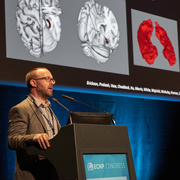
Choose a channel
Check out the different Progress in Mind content channels.

Progress in Mind







Adverse events such as abuse in childhood are closely related to risk of psychiatric disorder in adulthood. But the effects of such experiences are modulated by genetic factors. Can we begin to understand the daunting complexity of this interaction by looking at the stress hormone system, which is often dysregulated in psychiatric disorders?
The glucocorticoid receptor is a nuclear receptor which engenders a transcriptome-wide stress response in the cell. It is now clear that exposure to the stress hormone also remodels the epigenetic landscape, mostly through a decrease in DNA methylation.
Such changes, which (among other possible effects) had implications for neuronal differentiation were evident even after a washout period of twenty days. Effects were long lasting and seem capable of altering the impact of subsequent adverse stress-related events over a lifetime.
Basic molecular mechanisms are a good place to start when trying to understand complex gene-environment interactions
Such insights prompted work on multipotent human hippocampal progenitor cells. These cells react to glucocorticoids and so may represent a good model of early exposure to stress. In this model, exposure to dexamethasone produced the expected epigenetic changes in DNA methylation.
Importantly, these changes were found to be located in gene enhancer regions that are relevant both to brain development and to risk of mood disorders. Demethylation seems to prime genes to be more reactive to future stress.
But genetic variation modulates the epigenetic response to glucocorticoid activation and to changes in transcription. And it is revealing that SNPs linked by genome-wide association studies to increased risk of schizophrenia and depression are found in the loci showing methylation changes. This association may show – at a molecular level – how the risk of stress-related disorders is determined by both environmental and genetic factors.
There are certainly many non-glucocorticoid mechanisms that influence an individual’s vulnerability or resilience to mental health problems, Professor Binder concluded. But glucocorticoids do seem able to prime an organism to respond differently to stress.
Polygenic risk factors interact with the environment to increase vulnerability to depression. Do molecular events caused by exposure to stress hormones help us understand this complex interaction?




Proper brain development requires coordinated glycosylation, and in particular correct glycosylation of neural cell adhesion molecule (NCAM). The polysialylated version of NCAM (PolySia-NCAM) is vital in neurogenesis, playing a role in axon and dendritic outgrowth, and important for synaptic plasticity and normal neural development.
These were some of the key points made during a preclinical research track symposium entitled “Merging mouse and human data on the role of PolySia-NCAM in neurodevelopment and schizophrenia”, jointly chaired by Professor Herbert Hildenbrandt, of the Institute of cellular Chemistry, Hannover University, Germany and Professor Jean Mariani, of the Pierre and Marie Curie University, Paris, France.
In presentations by Dr Juan Nacher, of the University of Valencia, Spain and Dr Marta Barabara Wisniewska of the University of Warsaw, Poland, delegates learned of some of the latest research involving cultured immature neurones, animal models of neurodevelopment, imaging studies and research involving transgenic mice that point to the importance of normal polysialyation of NCAM in neurodevelopment. Dr Wiseniewska showed histological evidence of the impact of abnormal, or poly-Sia-free-NCAM, seen as demyelination and abnormal on neuronal structure and morphology.
Professor Hildebrandt described preclinical studies which suggest that in knock-out mice lacking an enzyme (ST8SIA2) responsible for modifying NCAM to PolySia-NCAM, the resulting reduced polysialyation leads to pathological brain development and schizophrenia-like behaviour. According to Professor Hildebrandt, a genetic variation in ST8SIA2 is not associated per se with schizophrenia but has been associated with schizophrenia where cognitive function is particularly poor, and he suggested that lacking ST8SIA2 has the potential to confer a neurodevelopmental predisposition to schizophrenia. He then went on to describe research suggesting that having this genetic deficiency, coupled with juvenile exposure to cannabis was linked with synergistic, negative effects on cognition in adulthood.
There has been inconsistent data regarding whether NCAM levels are increased or decreased in schizophrenia.
The final speaker at the symposium, Professor Gianfranco Spalletta, of the IRCCS Santa Lucia Foundation and Laboratory of Clinical and Behavioural Neurology in Rome, Italy, presented research findings relating to NCAM and polysialic acid serum levels in patients with schizophrenia. He said that there has been inconsistent data regarding whether NCAM levels are increased or decreased in schizophrenia. He reported his own, as yet unpublished data suggesting that PolySia-NCAM serum levels are significantly raised in schizophrenia and appear to be modifiable – as shown by lower levels in patients receiving treatment for the condition. He also reported that levels of this marker appear higher in patients with disease characterized by predominantly negative symptoms. Professor Spalletta said that brain neuroimaging studies may help with further understanding of the role of this intriguing molecule in subtypes of schizophrenia.
One of the first symposia on Day One ECNP 2015 was a research-track-focus on the possible roles of polysialylated neural cell adhesion molecule (PolySia-NCAM) in neurodevelopment and schizophrenia.
